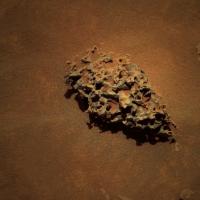Printable Version of Topic
Click here to view this topic in its original format
Unmanned Spaceflight.com _ Spirit _ Gong Gong
Posted by: Stu Dec 6 2009, 08:20 AM
I was looking through "MARS 3D" last night... again... and found a picture taken on Sol 736, of a rock called "Gong Gong" that caught my eye, because it looked a lot like some of the objects Oppy has been finding over on Meridiani recently. I went to the raw images site and made a colourisation from them...
... more and more familiar...
Checked up on the rock tho, and Steve Squyres said this in one of his updates:
"The name of this thing is GongGong, and it is what can happen when you have a very frothy, gas-rich lava that solidifies with lots of voids in it and then gets eroded by the wind for a very long time."
Anyone else thinks it looks like a badly eroded meteorite, like the ones Oppy has recently been collecting?
Posted by: nprev Dec 6 2009, 09:04 AM
Yeah, actually...good memory & great colorization, Stu! From the commentary, it seems unlikely that they did a mini-TES or a Mossbauer on GG, though, so we'll probably never know for sure. ![]()
Posted by: PaulM Dec 6 2009, 09:48 AM
The microscopic images of Gong Gong were some of the strangest that Spirit has ever made:
http://marsrovers.nasa.gov/gallery/all/spirit_m736.html
http://photojournal.jpl.nasa.gov/catalog/PIA02157
NASA's Mars Exploration Rover Spirit used its microscopic imager to capture this spectacular, jagged mini-landscape on a rock called "GongGong." Measuring only 3 centimeters (1.2 inches) across, this surface records two of the most important and violent forces in the history of Mars -- volcanoes and wind.
GongGong formed billions of years ago in a seething, stirring mass of molten rock. It captured bubbles of gases that were trapped at great depth but had separated from the main body of lava as it rose to the surface. Like taffy being stretched and tumbled, the molten rock was deformed as it moved across an ancient Martian landscape. The tiny bubbles of gas were deformed as well, becoming elongated. When the molten lava solidified, the rock looked like a frozen sponge.
Far from finished with its life, the rock then withstood billions of years of pelting by small sand grains carried by Martian dust storms that sometimes blanketed the planet. The sand wore away the surface until, little by little, the delicate strands that enclosed the bubbles of gas were breached and the spiny texture we see today emerged.
Even now, wind continues to deposit sand and dust in the holes and crevices of the rock.
Similar rocks can be found on Earth where the same complex interplay of volcanoes and weathering occur, whether it be the pelting of rocks by sand grains in the Mojave desert or by ice crystals in the frigid Antarctic.
GongGong is one of a group of rocks studied by Spirit and informally named by the Athena Science Team to honor the Chinese New Year (the Year of the Dog). In Chinese mythology, GongGong was the god-king of water in the North Land. When he sacrificed his life to knock down Mount BuZhou, he defeated the bad Emperor in Heaven, freed the sun, moon and stars to go from east to west, and caused all the rivers in China to flow from west to east.
Spirit's microscopic imager took this image during on the rover's 736th day, or sol, of exploring Mars (Jan. 28, 2006). The rock lies in the "Inner Basin" between "Husband Hill" and "McCool Hill" in Gusev Crater. Spirit acquired the image while the rock was fully shadowed, with diffuse illumination mostly from the top in this view.
Posted by: Stu Dec 6 2009, 10:05 AM
Thanks Paul, really appreciate your post, very enlightening. I was just struck by the visual similarity, that's all. Absolutely fascinating to think of the forces, processes and time that shaped that little rock, isn't it?
Posted by: ElkGroveDan Dec 6 2009, 03:36 PM
I think the difference between Gong Gong and the Meridiani iron meteorites is the number and depth of the vesicular cavities. On the iron objects the cavities appear to be at the exposed surface - former dimples and indents that were eroded into large cavities by the wind over the eons. They are wider and larger on the outside and smaller as you go inward. With Gong Gong (especially in the MI's) look closely and see how deep and intricate the cavities are, and how uniform it all appears toward the interior. My sense is that the original identification was correct.
Posted by: fredk Dec 6 2009, 04:59 PM
Definitely a resemblence - thanks for reminding us of some cool rocks. That area was chock full of similar frothy bits - for example check out
http://marsrovers.jpl.nasa.gov/gallery/all/2/p/740/2P192056259ESFANMGP2569L7M1.JPG
http://marsrovers.jpl.nasa.gov/gallery/all/2/p/740/2P192053826EFFANMGP2519R1M1.JPG
Posted by: Oersted Dec 9 2009, 12:42 PM
Styu, great that you remembered this rock and inquired about it. Inquiries like that are what keep the scientific process going forward!
Powered by Invision Power Board (http://www.invisionboard.com)
© Invision Power Services (http://www.invisionpower.com)

